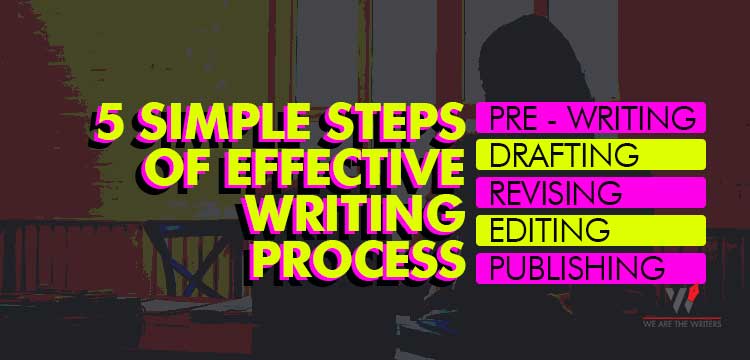As a writer, everyone is different. Writing makes every individual unique in his/her style. This difference in style not just gets reflected in the presentation but also in the process.
The presentation depends on how well the process is organized. Here the importance of dividing the writing process into further steps comes into play.
Table of Contents
Introduction To The Writing Process
Writing is the expression of facts and ideas from a rough to a final form. It’s the natural rhythmic flow of thoughts arranged sequentially leading up to a common central idea. Moreover, excellence in writing reflects the individual’s capacity to have written conversation and communication.
From 3500-3000 BCE, when the ancient Mesopotamians engraved Cuneiform on rocks, writing still remains a medium of instruction and communication. Excellent and effective skills are of vital importance for every student to survive in the international job market of competition. Thus, everyone needs to know to write and express facts & their emotions in a properly organized manner.
Suggested Blogs
- Pre Writing – The First Step of Writing Process – 5 min read
- 5 SEO Content Writing Tips you wish you got earlier !
- SEO Copywriting vs SEO Content Writing | Learn the difference in 6 minutes
Importance Of Dividing The Writing Process Into 5 Simple Steps
Writing can never be a one-way process. The content resulting in the end ultimately reflects the path taken to reach it. A crystal clear writing process is essential to make the presenting content look appealing, clearer, and presentable. Moreover, these steps in the writing process make the process a lot more comfortable & easier.
Besides facilitating the writing process, steps also reduce the chances of procrastination. The entire topic gets divided into small chunks of subtopics, making things faster, easier, and more organized. Thus, working on numerous small projects is better than working on a huge project.
5 Simple Steps Of Effective Writing Process

An effective writing process consists of 5 steps that start with pre-writing and end with the final publishing of the content. Thus, the five steps which make up the writing process includes:
- Pre – Writing
- Drafting
- Revising
- Editing
- Publishing
Let’s learn about each of these steps in a detailed manner.
Pre – Writing
Writing great content needs planning. The writer cannot just put random things in random places. Information with proper arrangement can give a complete sense of the content. So far, pre-writing is concerned; people are more often neglecting the importance of all the steps before starting to write anything. To be more specific, topic understanding, research, categorization, and all other factors can decide the efforts that need to be put on a particular write-up.
No doubt, one cannot gather everything before writing. A writer will always need to research and collect during the process of writing. But a perfect start can help the writer shape out a striking introduction to the content of the topic. The writer can list all the information, which he wants to stuff in the content. Arrange authoritative sources to improve the credibility of the write-up.
Anything that is written must have a definite reader. So, understanding the target audience and writing the content according to their taste can be understood by pre-writing strategies.
Every writer has their way to start with or can follow any strategy. But the most common and effective strategy of pre-writing, which the writer can use is here,
Freewriting
As the name suggests, the writer is free from any cost of grammar, punctuation, or spelling in this strategy. The writer can express everything related to the topic that is present in his mind without any fear of perfection and purity. This method’s only intention is to extract all the necessary information that is pre-existing in the writer’s mind.
This will increase the writing pace, creativity, and the dimension of thoughts of the writer. The approach is also improved along with output.
Clustering
Clustering is a brainstorming method with exceptional ideas like categorization, mind mapping, diagramming, etc. Apart from forming the subject, this strategy needs visualization strength. Everything that revolves around the topic is necessary, which the writer needs to find the relation and the way to visualize it.
Outlining
An outline sums up everything the writer has gathered in the freewriting and clustering in an organized way. Organizing or forming the final outline of the whole content is what the strategy consists of. The writer can get all the important points right before in the outline. It makes the rest process easier.
Drafting

The writer has crossed the prewriting strategy to get an outline. Use that outline to form the draft content. The content can be flexible as this will be the draft write-up, which will be edited further. The drafting work can be freely performed, which is centered on ideas and thoughts only. The grammatical purity can be revised later for editing and proofreading.
Suggested Blogs:
- Discover what is brochure writing | How to write brochure
- Master novel writing and convey a great story in 2022
- WHAT IS INFORMATIVE WRITING [Techniques + Examples ]
In drafting, the writer should completely focus on expressing every thought clearly before the readers. Content formation and drafting are more important than pointing to grammatical purity. This does not mean the writer will use the meaningless grammatical structure of sentences. The main objective is to focus on creating the first draft of the content.
Revising
Revision forms a significant part of the writing process. Here, the writer identifies the flaws and shortcomings of his own draft. During drafting, it’s better to go through the draft and read it before someone.
Reading the draft before someone is essential as it helps the writer understand the target audience better. At some points, the writer may discover the lack of research. At some other points, he may discover repeated sentences or phrases or lack of some logical information.
However, don’t jump into revising your first draft right after writing it. Make sure to maintain a healthy time gap of at least 4-6 hours between the completion of your first draft and the starting of your first editing. This healthy time gap is necessary to identify the strengths and weaknesses of your first draft.
Besides, you can take as much time as you want for editing. Spend more time revising. This will help you understand the loopholes in your content and arguments better, thereby helping you bring the necessary improvements and changes.
Editing
The editing process includes polishing the content and improving grammatical purity along with spelling, punctuation, and all. The process needs detailed analysis, an understanding of information handling, and English grammatical knowledge. The whole write-up must be free from spelling mistakes and punctuation errors.
But the editing process should be started after the whole content is revised. Read the content and make sure all the content is present, which is important, and all the unnecessary information should be omitted. After that, he has the final revised content then he can start editing. There is no point in editing the content if you are going to omit it at the end. So, make sure the unnecessary part should be removed.
Although editing has a lot of other styles like format editing, content editing, grammar editing, etc., formatting is also necessary to present the content and information. The editing process also makes sure the content is free from any filler sentences, repeated phrases, or uncertain language.
Sometimes the writer cannot edit the content properly, and there are chances that he can miss some editing points. In that case, the writer can suggest someone read once to overview the entire content. Computer software can be used for editing, which can make the process easier and effective. The chances of writing impurity are also less in software editing. Once it is done, the edited and proofread content is ready for publication processes.
Publishing

The publishing of the content required audience analysis before launching it before the public. Understanding the audience of the content is important. If the content has a specific readers group, then the publishing process should focus on the reading group. If the content is published on social media platforms, the process should consider the target audience. If the content is published on blogs or websites, then proper SEO treatment is required.
The offline publication of the write-up needs to be published by established publication houses. Apart from the publishing process, the post publishing process includes marketing of the content, which is also an important aspect of publishing the content.
Suggested Blogs:
- Copywriting vs Content Writing – The Definition and Difference
- How to Write Email | Easy Email Writing Format -10 mins read
- SEO Copywriting – A Strong Appeal to Users and Algorithms
Bottom Line | Writing Process
Writing is a complex process. However, this process is simplified when it’s done in small chunks. No matter how hard the topic is, it always leads to a handful of content during the research when it has a proper layout. This research then leads to the first draft, which is full of information and stuff.
And then, the final arrangement of these researched data in a sequential manner brings forward the final content, which satisfies the audience’s search intent. The main motive of writing is to satisfy the search intent of the user.
It’s then when the written content appeals to the reader and answers his questions, that the writer feels great about his own write-up. Thus, the entire journey of an effective write-up comprises 5 steps, which almost all writers follow with some minor variations in their practices.
Reference : The Prewriting Stage of the Writing Process





 WhatsApp
WhatsApp